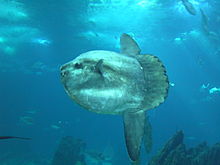| Molidae Temporal range:
| |
|---|---|

| |
| Mola mola | |
| Scientific classification | |
| Domain: | Eukaryota |
| Kingdom: | Animalia |
| Phylum: | Chordata |
| Class: | Actinopterygii |
| Order: | Tetraodontiformes |
| Suborder: | Tetraodontoidei |
| Family: | Molidae Bonaparte, 1832 |
| Genera[2] | |
The Molidae comprise the family of the molas or ocean sunfishes, unusual fish whose bodies come to an end just behind the dorsal and anal fins, giving them a "half-fish" appearance. They are also the largest of the ray-finned bony fish, with the southern sunfish, Mola alexandrini, recorded at 4.6 m (15 ft) in length[3] and 2,744 kg (6,049 lb) in weight.
The family name comes from the ocean sunfish's scientific name Mola mola, both its genus name and epithet come from the Latin word mola for "millstone" because of its circular shape.[4]
- ^ Tyler, James C.; Bannikov, Alexandre F. (1992). "New genus of primitive ocean sunfish with separate premaxillae from the Eocene of Southwest Russia (Molidae, Tetraodontiformes)". Copeia. 1992 (4). Copeia, Vol. 1992, No. 4: 1014–1023. doi:10.2307/1446631. JSTOR 1446631.
- ^ Matsuura, K. (2014): Taxonomy and systematics of tetraodontiform fish: a review focusing primarily on progress in the period from 1980 to 2014. Ichthyological Research, 62 (1): 72–113.
- ^ "Massive Huge Sun Fish off of Portugal 15 foot plus". YouTube. 6 October 2015. Retrieved 1 March 2019.
- ^ Scharpf, Christopher; Lazara, Kenneth J. (12 June 2023). "Family TETRADONTIFORMES" (PDF). The ETYFish Project. Retrieved 30 October 2023.